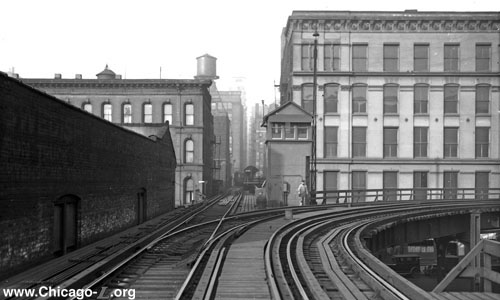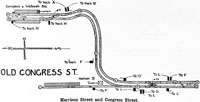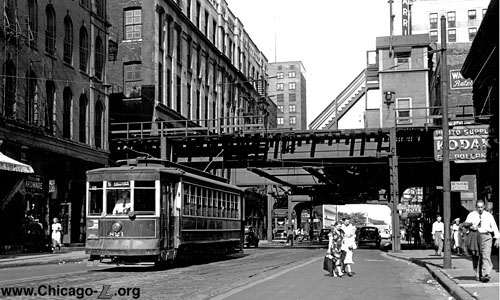.

Harrison Junction and its interlocking tower are seen looking north circa 1925. The two tracks curving to the right lead to the Loop, while the single track continuing north leads to the Old Congress station, whose single side platform and hump-roof canopy can be seen in the distance. A North Shore Line 250-class combine is loading baggage at the platform -- from 1919 to 1963, the interurban used
the Congress stub terminal for loading and unloading baggage for its downtown Chicago passengers. For a larger view, click here. (Photo courtesy of the Krambles-Peterson Archive)
|
Harrison
Junction
Harrison Street and
Holden Court, Loop
Service
Notes:
|
Services:
|

|
South Side
Division
|
Quick Facts:
Established: October 18, 1897 (junction), 1902 (interlocking and tower)
Original Line: South Side Elevated Railroad
Rebuilt: n/a
Status: Demolished
Profile:
Harrison Junction was established on October 18, 1897, when the
Union Loop opened and all South Side trains were
rerouted there. A track connection between the South Side Elevated's original line, which continued north over a narrow alley called Victoria Avenue (later renamed Holden Court) to Congress Street, and the Loop was made at Harrison Street, one block south of the Congress terminal. The South Side-Loop connector took the form of an extension of the two-track main line curving east at Harrison then back north over Wabash Avenue, creating one of the tightest S-curves on the "L", then two blocks north to Van Buren Street to meet the southeast corner of the Loop at a junction called Tower 12.
Connection to the Congress terminal was maintained with a single track continuing north from the new curve at Harrison Street, with a junction at Harrison and Holden where the two lines met. However, all trains were rerouted to the new Loop and the small, one track station became superfluous and was closed. Therefore, at this point the junction seems likely to have only had hand-throw switches with no tower, since there was no scheduled passenger service into the old terminal spur -- the connection was made in case access was needed, and the dormant stub terminal was left in
place on the chance that it would be needed again.
That day was soon in coming. On March 10, 1902, the
terminal station was reactivated to several handle rush hour trains
that could not be accommodated in the Loop due to the downtown tracks having reached capacity. To distinguish
it from the Congress/Wabash station a
half block east on the Loop connector, the Congress terminal was thereafter often referred to as "Old
Congress".
|

Layout of Harrison Junction in 1913. For a
larger view, click here. (Reprinted from Instructions to Trainmen in Connection with Through Routing, issued by CER to employees in 1913, Graham Garfield Collection) |
A tower and interlocking plant were installed at Harrison Street to control access between the main line to and from the Loop and the Congress terminal stub track, since there was now regularly-scheduled revenue service in and out of the stub terminal and trains needed to be directed between the two routes. The tower was located in the gore of the junction, between the single track continuing due north to the Congress stub and the southbound track of the double-track main line curving from over Harrison Street to over the alley (Holden Court) of the line to the South Side. The interlocking controlled the switch between the Congress stub track and the southbound main line track, as well as a diamond crossover between the two main line tracks immediately to the south -- northbound trains destined for Old Congress had to be switched through this diamond from the northbound main line track to the southbound main line track, then onward through the switch leading from the southbound main to the stub track.
In 1913, when "L" services were through-routed between the North and South sides, a smaller number of South Side trains continued to run only between downtown and the outlying terminal at rush hours. As a result, a towerman was only on duty at Harrison Tower during morning and afternoon weekday periods, when Old Congress was open to traffic. At all other times, all trains went to and from the Loop and the Congress stub was inactive, eliminating the need to route trains in and out of the stub terminal track. The exact staffing hours of the tower changed over the years, however, especially after the Chicago North Shore & Milwaukee Railroad extended
operations into downtown Chicago via the "L" and the interurban began to use the Old Congress stub terminal to handle and load baggage.
The level of "L" service in and out of the Congress terminal continued to wain over the years until finally the CTA implemented its massive north-south service revision that streamlined service, instituted of A/B
skip stop service on the new North-South
Route, and closed 23 stations including the Congress Terminal. Effective August 1, 1949, the last "L" service was withdrawn from the Congress stub terminal.
The Congress stub facility continued in use as the
North Shore Line's baggage terminal, however, still requiring the tower at Harrison Junction to route trains in and out of the spur. This operation continued until the interurban abandoned service on January 21, 1963. The Congress baggage room facility was officially closed effective this date. The stub track was not officially removed from service until November 20, 1964, though it had been inactive for that nearly-two-year period. It is likely that the stub track and structure north of Harrison Junction, the junction itself, and the tower were demolished not long after.

Harrison Tower is seen on the "L" structure over Harrison Street looking east from State Street on July 22, 1949. "L" service into the Congress stub would end about a week later, but the tower would continue in use for more than a decade while the North Shore Line used the Congress spur. CTA streetcar 821 is working the #5 Cottage Grove-South Chicago service, a through-route that would be discontinued about four months later. For a larger view, click here. (Photo by Thomas H. Desnoyers, courtesy of the Krambles-Peterson Archive)
|





